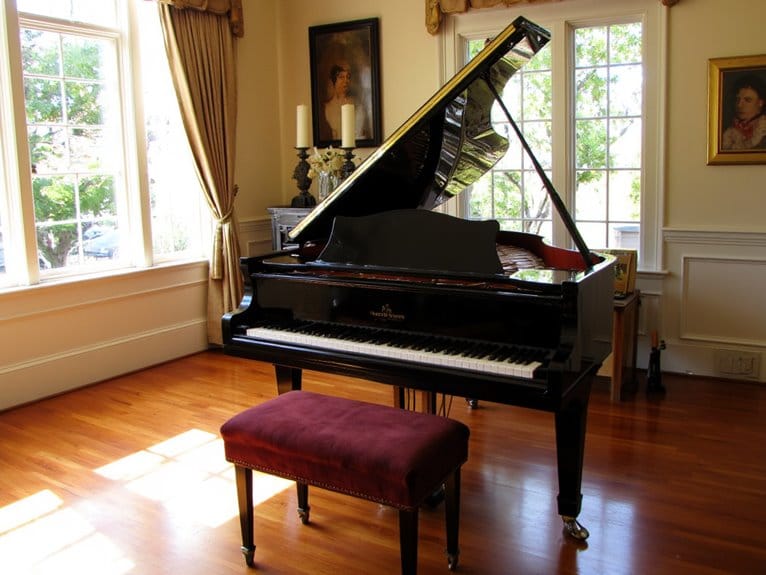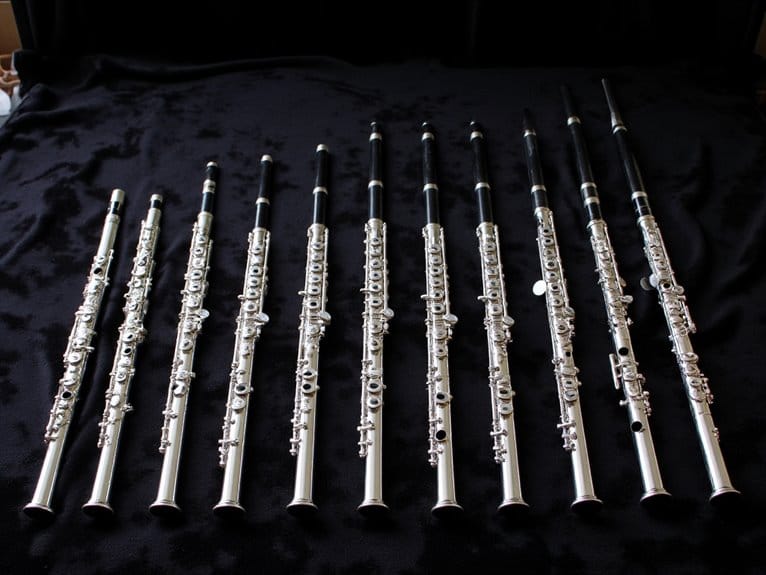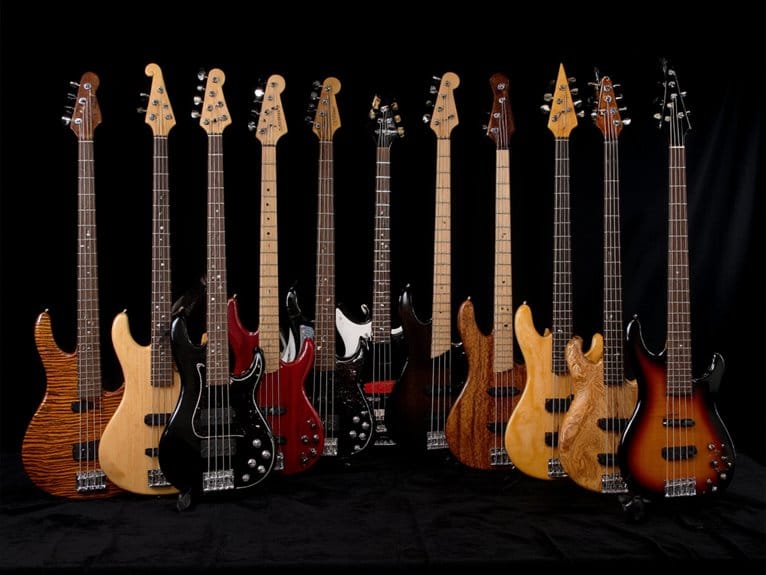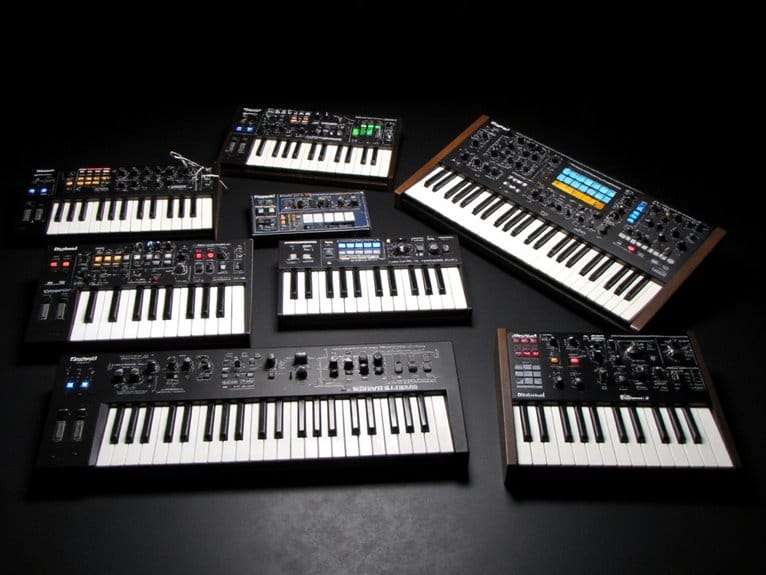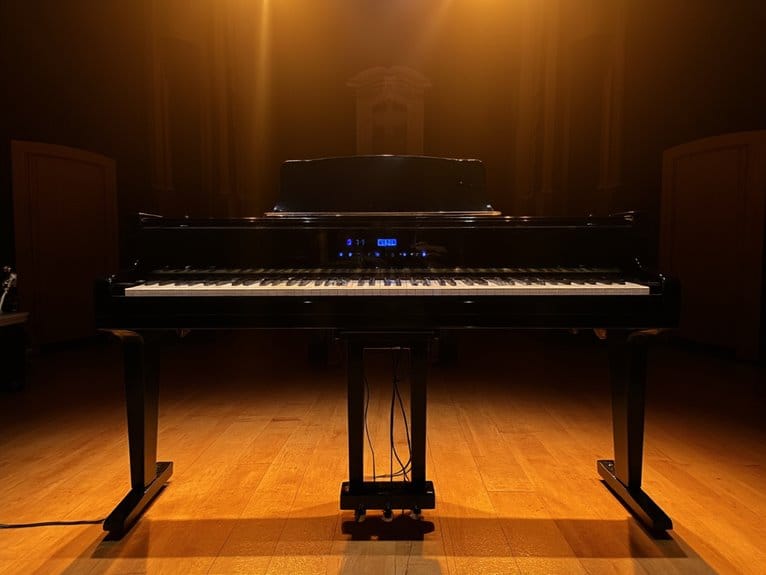10 Best Pianos for Home That Will Transform Your Living Space
After testing digital pianos in countless living rooms, I’ve found that models like the STRICH SDP-120 with its fully-weighted 88 keys and dual 15W speakers deliver authentic grand piano feel while serving as elegant furniture pieces. The Yamaha P143B offers exceptional portability at lightweight design, while the Fesley FEP760 brings professional-grade Bluetooth connectivity that seamlessly integrates with modern smart homes, transforming any space into a sophisticated musical sanctuary where each model’s unique features reveal remarkable potential.
We are supported by our audience. When you purchase through links on our site, we may earn an affiliate commission, at no extra cost for you. Learn more.
Notable Insights
- Choose 88-key weighted digital pianos like STRICH SDP-120 or Yamaha P143B for authentic acoustic piano experience in home settings.
- Consider space requirements as digital pianos range 53.5-58.5 inches wide, with heavier models like WENCAI requiring two-person assembly.
- Prioritize models with dual speakers and quality amplifiers like Fesley’s 20-watt or 88-Key Weighted’s 25-watt systems for rich sound.
- Select pianos with Bluetooth and MIDI connectivity for seamless integration with apps and modern digital audio workstations.
- Opt for portable options like Donner DEP-08 with removable stands for flexible placement and easy relocation within living spaces.
STRICH 88 Keys Weighted Digital Piano with Stand & Sustain Pedal (SDP-120)
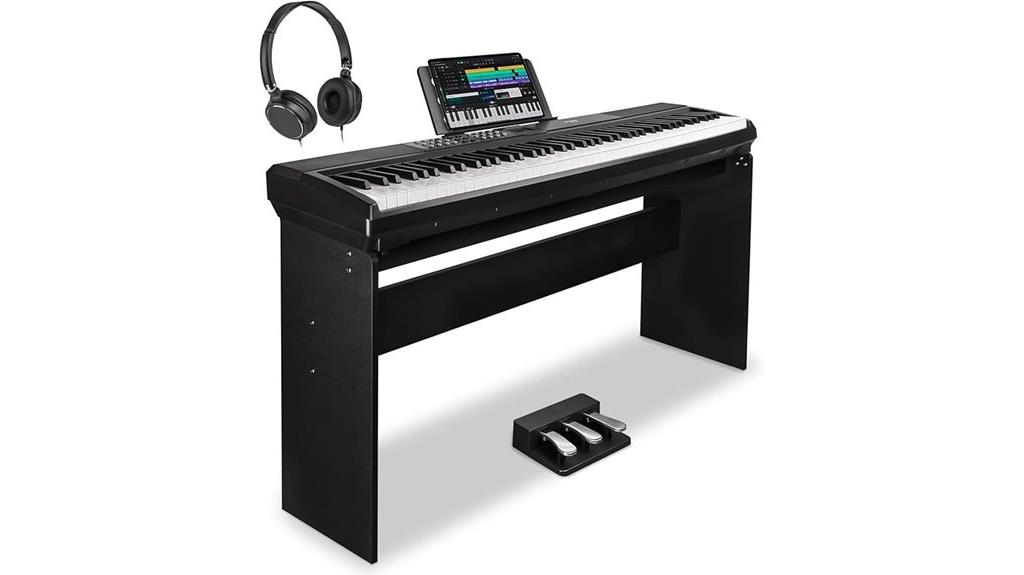
When you’re searching for a digital piano that delivers authentic grand piano feel without breaking the bank, the STRICH SDP-120’s fully-weighted 88-key design stands out as an exceptional choice for both beginners taking their first steps and seasoned players who demand responsive touch sensitivity. You’ll appreciate the hammer-action keys that replicate traditional piano mechanics, while the 200 tones and 700 rhythms provide versatility across classical, jazz, and contemporary genres. The dual 15W speakers deliver surprisingly robust sound quality, though you might encounter occasional connectivity hiccups with software like GarageBand that require patience to resolve.
Best For: Beginners and experienced pianists seeking an affordable digital piano with authentic weighted key action and versatile sound options for home practice and performance.
Pros:
- Fully-weighted 88 keys with hammer-action provide realistic grand piano feel and responsive touch sensitivity
- Extensive sound library with 200 tones and 700 rhythms covering classical, jazz, pop, and world music genres
- Strong value proposition with dual 15W speakers, multiple connectivity options, and included stand and sustain pedal
Cons:
- Connectivity issues reported with music software like GarageBand requiring troubleshooting
- Unclear manual and default volume settings can create initial setup confusion
- Some accessory quality concerns including headset quality and short power cord length
88-Key Weighted Digital Piano with 3 Pedal (with Bench, White)
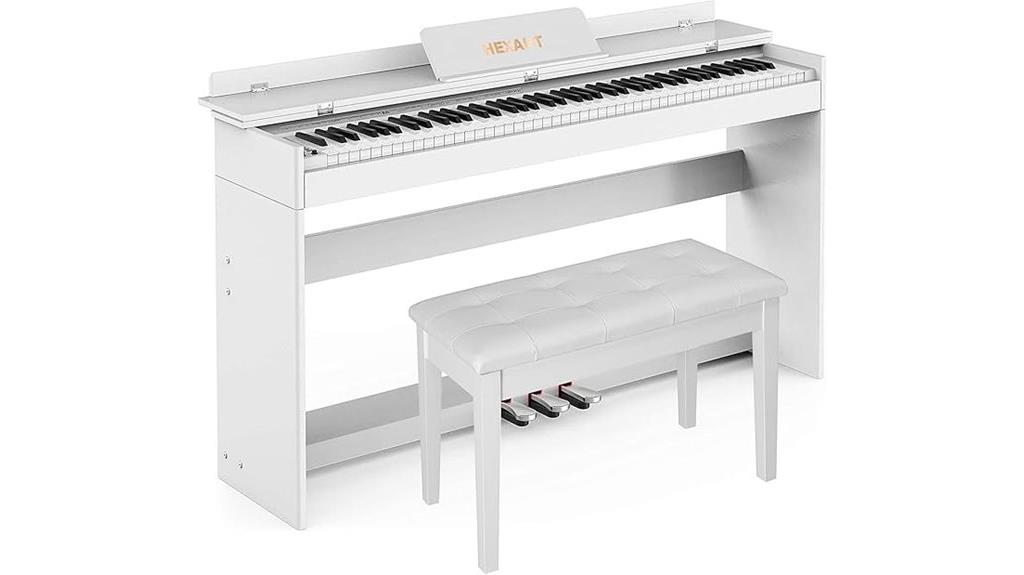
This 88-key weighted digital piano stands out as an exceptional choice for families and beginners who want authentic piano experience without sacrificing modern convenience, combining three essential pedals, dual 25-watt amplifiers, and a matching bench in an elegant white finish. You’ll appreciate its progressive key design that simulates real acoustic piano feel through velocity sensitivity, while the backlit LCD display manages 480 tones, 200 rhythms, and 64-note polyphony effortlessly. The extensive connectivity options include USB, MIDI ports, and headphone jacks for versatile practice sessions. Though some users report occasional durability concerns, most find it offers exceptional value compared to Roland or Yamaha alternatives.
Best For: Families and beginners seeking an authentic piano experience with modern convenience features at a value price point compared to premium brands.
Pros:
- Progressive weighted keys with velocity sensitivity simulate real acoustic piano feel
- Comprehensive features including 480 tones, 200 rhythms, 3 pedals, and dual 25W amplifiers
- Excellent connectivity options with USB, MIDI ports, and headphone jack for versatile practice
Cons:
- Durability concerns reported by some users with sound failure and volume issues
- Poor customer service response for warranty claims and defective units
- Mixed reviews on overall build quality and long-term reliability
Fesley Digital Piano 88 Key Weighted Keyboard with Bluetooth & MIDI USB
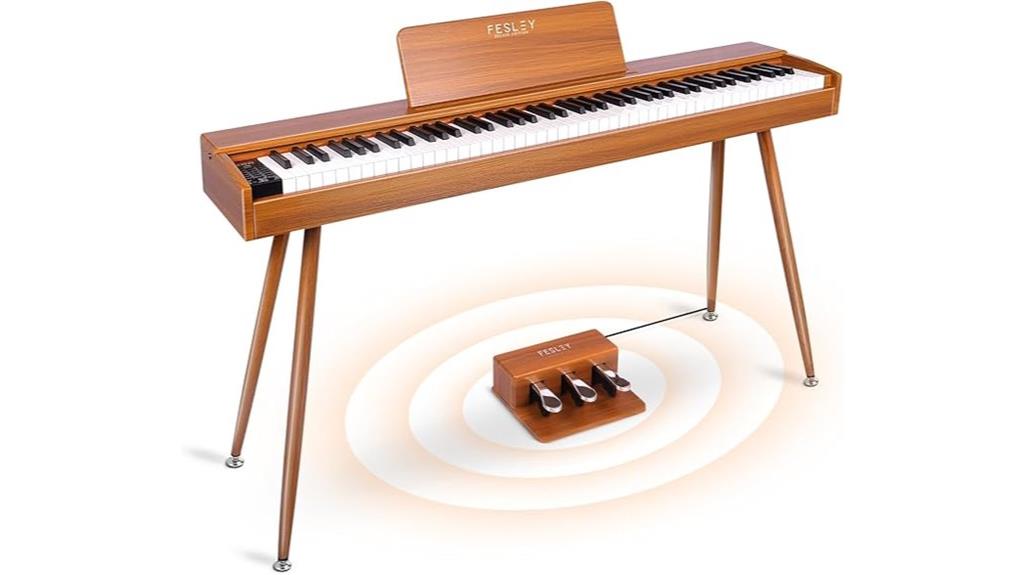
Beginners and intermediate players who want professional-grade features without the acoustic piano price tag will find the Fesley Digital Piano FEP760 strikes an impressive balance between affordability and performance. You’ll get 88 weighted keys with graded hammer action that genuinely mimics acoustic piano touch, plus dual 20-watt speakers delivering surprisingly rich sound through its French Dream source. The connectivity options include Bluetooth, MIDI USB compatibility with major DAWs like Logic and Ableton, and dual headphone jacks for quiet practice sessions. While some users struggle with touch sensitivity adjustments and menu navigation, the triple pedal system and recording functionality make this an excellent choice for serious practice.
Best For: Beginners and intermediate players who want professional-grade features and authentic piano feel without the high cost of an acoustic piano.
Pros:
- 88 weighted keys with graded hammer action that genuinely replicates acoustic piano touch
- Excellent connectivity options including Bluetooth, MIDI USB compatibility with major DAWs, and dual headphone jacks
- Rich sound quality from dual 20-watt speakers with French Dream sound source and comprehensive features like triple pedal system
Cons:
- Touch sensitivity adjustments can be difficult to configure properly
- Menu navigation system is not user-friendly
- Some users report inconsistent touch dynamics affecting playing experience
88 Key Digital Piano with Bluetooth & MIDI
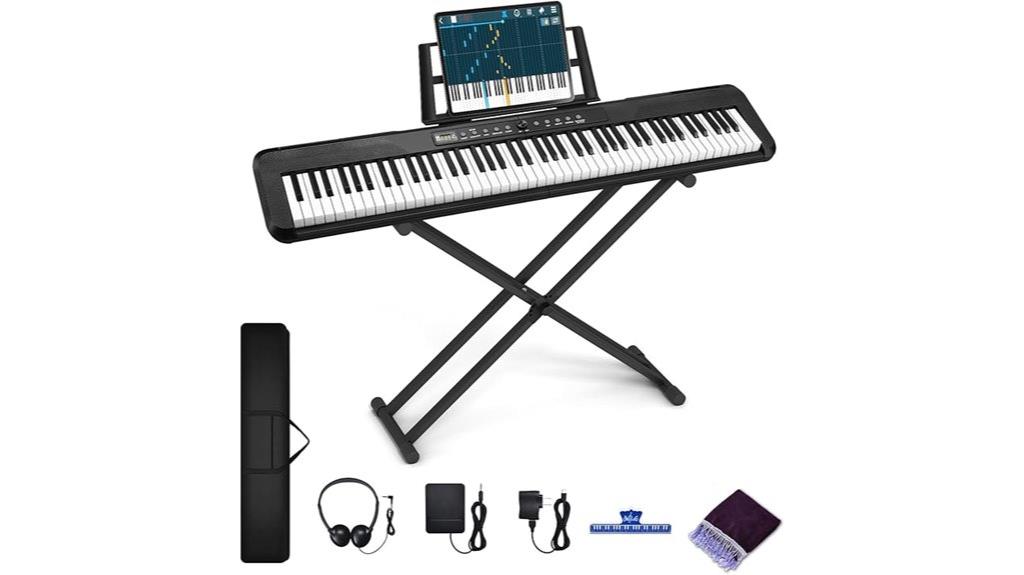
Looking for an affordable entry point into digital piano playing, I’ve found that the 88 Key Digital Piano with Bluetooth & MIDI stands out as a compelling option for beginners and budget-conscious musicians who need modern connectivity features without breaking the bank. At 14.87 pounds, this semi-weighted keyboard offers surprising portability while maintaining realistic touch response through velocity-sensitive keys that adapt to your playing strength. The 200 rhythms and polyphony options, combined with 80 demo songs, provide extensive learning materials for developing musicians. I appreciate the dual connectivity through Bluetooth and MIDI input/output, which enables seamless computer integration for music arrangement software, while battery power guarantees you can practice anywhere without hunting for outlets.
Best For: Beginners, budget-conscious musicians, and music students who want an affordable 88-key digital piano with modern connectivity features like Bluetooth and MIDI for home practice and learning.
Pros:
- Excellent portability at 14.87 pounds with battery power for practice anywhere without needing electrical outlets
- Comprehensive connectivity options including Bluetooth and MIDI input/output for seamless integration with computers and music software
- Rich feature set with 200 rhythms, 200 polyphony, 80 demo songs, and semi-weighted velocity-sensitive keys at an affordable price point
Cons:
- Plastic construction may feel less durable compared to higher-end digital pianos with wooden or metal components
- Assembly instructions can be challenging based on customer feedback, potentially causing setup difficulties
- Semi-weighted keys, while good for beginners, may not fully replicate the authentic feel of acoustic piano action for advanced players
Yamaha 88-Key Digital Piano with Weighted Keys (P143B)

Weighing just 24.5 pounds with compact dimensions that fit into most living spaces, the Yamaha P143B delivers authentic acoustic piano expression without the bulk or maintenance demands of a traditional instrument. The Graded Hammer Compact action provides weighted keys that genuinely replicate acoustic piano touch, while ten unique voices offer versatility beyond basic piano sounds. You’ll appreciate the USB connectivity for MIDI capture and the compatibility with Smart Pianist app, which streamlines recording and social media sharing. The included sustain pedal feels basic, and some users note darker sound qualities compared to real pianos, but the 4.7-star rating reflects solid performance for beginners and hobbyists.
Best For: Beginners, students, and hobbyists who need a portable digital piano with authentic weighted keys and acoustic piano feel for practice, performance, and creativity in compact living spaces.
Pros:
- Graded Hammer Compact action with weighted keys provides realistic acoustic piano touch and feel
- Compact and lightweight design (24.5 pounds) makes it highly portable while fitting in most living spaces
- USB connectivity and Smart Pianist app compatibility enable easy MIDI capture, recording, and social media sharing
Cons:
- Included FC5 sustain pedal is basic and not considered elegant or advanced
- Sound quality is notably darker compared to real acoustic pianos
- Limited to 10 voices, which may restrict versatility for more advanced users
Donner Digital Piano Keyboard 88 Keys with Stand (DEP-08)
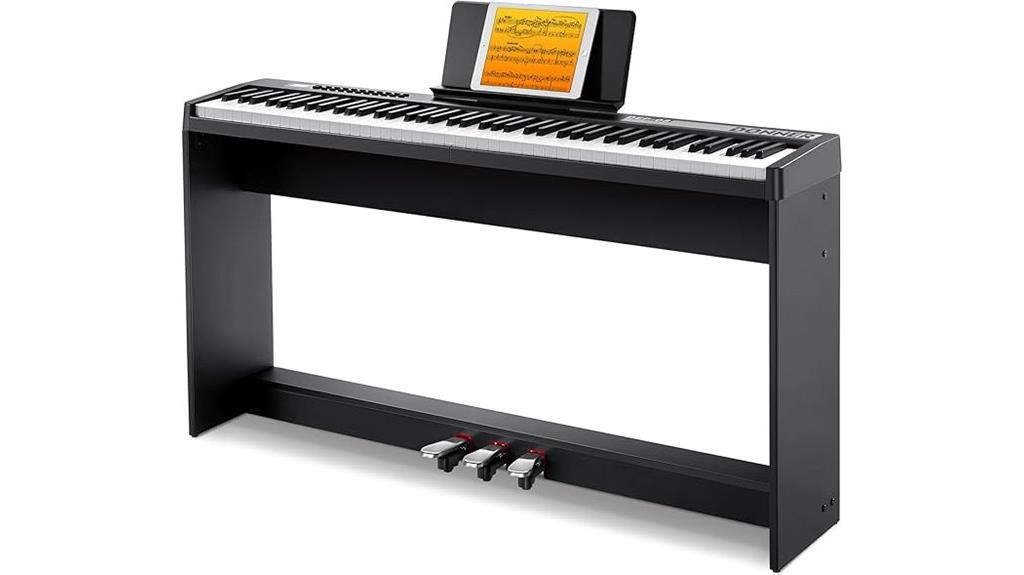
The Donner Digital Piano Keyboard 88 Keys with Stand (DEP-08) emerges as a compelling gateway instrument for young aspiring pianists, particularly those aged 14 and under who need a full-sized keyboard experience without the overwhelming complexity of professional-grade features. You’ll appreciate its practical 380 tones, 128 polyphony, and thoughtful teaching modes that include split functionality for sound comparison and numbered key stickers. The velocity-sensitive keys respond adequately to your touch, though seasoned players might notice the pressure sensitivity feels less refined than premium alternatives. At 33.8 pounds with removable stand, you can relocate this instrument easily, while USB MIDI connectivity guarantees seamless computer integration for modern learning applications.
Best For: Young aspiring pianists aged 14 and under who need a full-sized keyboard experience with beginner-friendly features and teaching support.
Pros:
- Comprehensive feature set with 380 tones, 128 polyphony, and teaching modes including split functionality and numbered key stickers
- Portable design at 33.8 pounds with removable stand and multiple connectivity options including USB MIDI
- Strong value proposition with velocity-sensitive keys and recording capabilities ideal for learning and creativity
Cons:
- Key pressure sensitivity feels less refined compared to premium alternatives
- Size may not be suitable for taller players
- Limited age range targeting may restrict appeal for adult beginners
88 Key Digital Piano with Bluetooth and MIDI
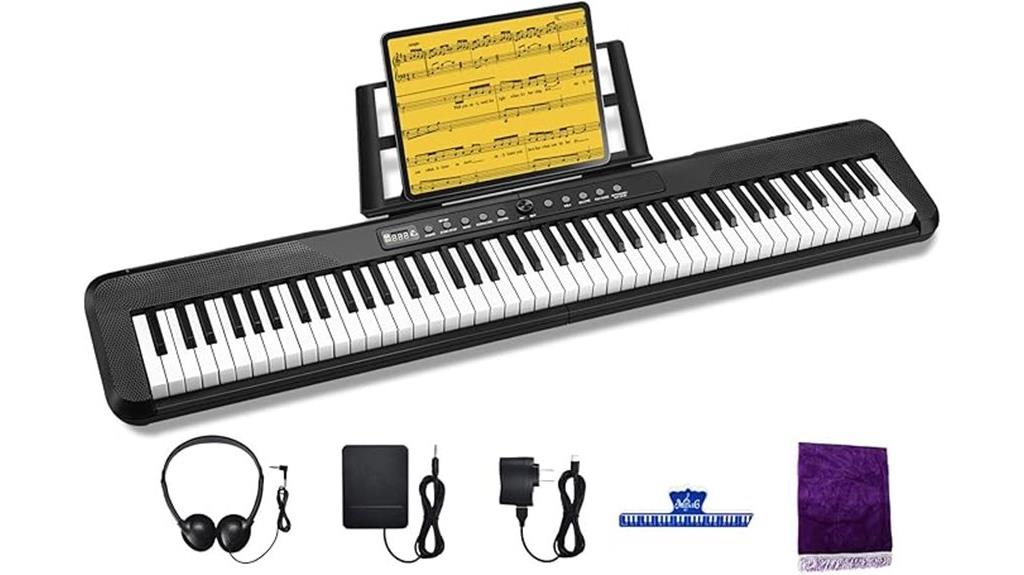
When you’re searching for an instrument that bridges the gap between acoustic authenticity and modern convenience, an 88-key digital piano with Bluetooth and MIDI capabilities emerges as the ideal choice for beginners and intermediate players who value both traditional touch and technological flexibility. You’ll appreciate its semi-weighted keyboard design, which restores grand piano touch while offering quicker rebound than full-weighted alternatives, making practice sessions more comfortable during extended playing periods. The 200 polyphony, combined with 200 rhythms and 80 demo songs, provides exceptional versatility for performance and learning, while dual keyboard functionality transforms it into an effective teaching tool for instructors and students alike.
Best For: Beginners and intermediate players who want an authentic piano experience with modern connectivity features for learning, teaching, and versatile musical exploration.
Pros:
- Semi-weighted keys with velocity sensitivity provide realistic piano touch while being more comfortable than full-weighted keys for extended practice
- Comprehensive connectivity options including Bluetooth and MIDI allow wireless connection to apps, software, and external devices
- Complete package with 200 polyphony, dual keyboard function, built-in speakers, battery power, and all necessary accessories included
Cons:
- Semi-weighted keys may not provide the full authentic feel that advanced pianists expect from acoustic pianos
- Battery-powered portable design may compromise speaker quality compared to larger stationary digital pianos
- Limited to 80 demo songs which may not provide enough variety for long-term learning progression
KU-3506 Digital Piano 88 Key Semi Weighted Keyboard with Stand
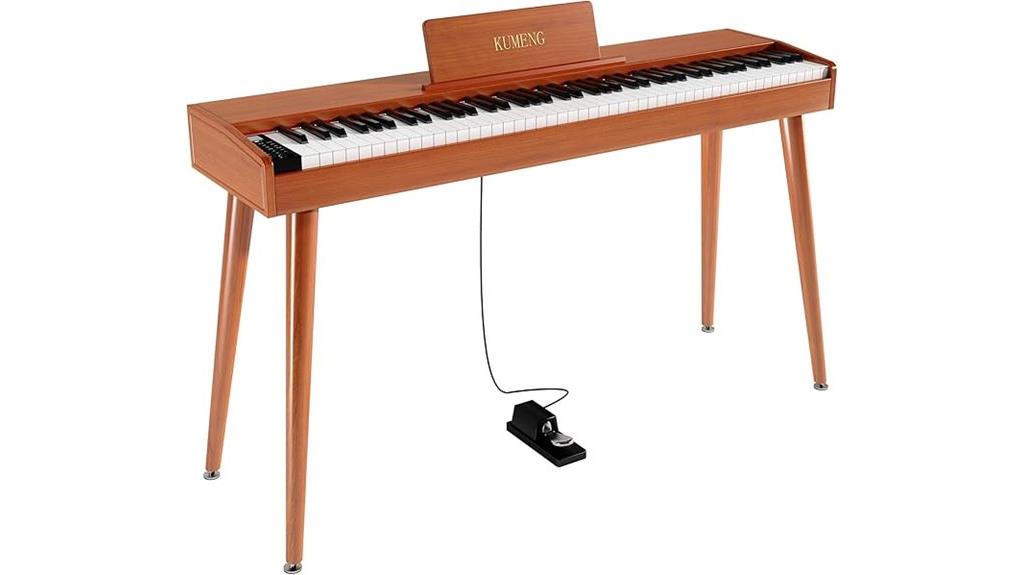
Budget-conscious beginners seeking their first full-sized digital piano will find the KU-3506’s semi-weighted 88-key design strikes an ideal balance between affordability and authentic playing experience, though I’ll admit the sparse instruction manual might leave you searching YouTube for setup guidance. You’ll appreciate the sophisticated chip delivering realistic acoustic piano simulation, complemented by 800 tones and 128-note polyphony that accommodates diverse musical styles. The USB/MIDI connectivity seamlessly pairs with tablets, PCs, and music software like GarageBand, while the dual keyboard split function proves invaluable for instructor-guided practice sessions in your home.
Best For: Budget-conscious beginners and casual players who want a full-sized 88-key digital piano with realistic sound quality and modern connectivity features for home practice and learning.
Pros:
- Semi-weighted 88-key design provides authentic playing experience while remaining affordable for beginners
- Extensive sound library with 800 tones and 128-note polyphony plus USB/MIDI connectivity for music software integration
- Complete package includes essential accessories (stand, pedal, power adapter) and dual keyboard split function for instructor-guided lessons
Cons:
- Sparse instruction manual requires users to seek online tutorials for proper setup and operation guidance
- At 29.7 pounds, the weight may make it less portable compared to smaller keyboard alternatives
- Semi-weighted keys, while suitable for beginners, may not fully replicate the feel of acoustic piano weighted keys for advanced players
RockJam Compact 61 Key Keyboard with Sheet Music Stand & Piano Lessons
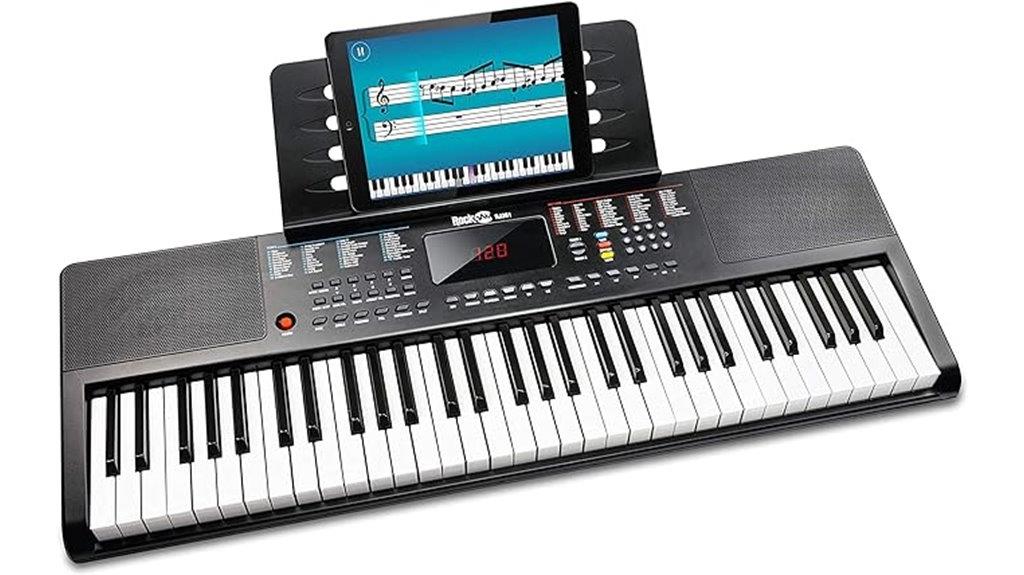
Aspiring pianists seeking their first instrument will find the RockJam Compact 61 Key Keyboard strikes an impressive balance between affordability and functionality, making it an ideal entry point for beginners who need essential features without breaking the bank. You’ll appreciate the 200 built-in sounds and rhythms that provide ample experimentation opportunities, while the included piano note stickers help visualize finger placement during those critical early learning stages. The Simply Piano app integration elevates your practice sessions beyond basic button-pushing, offering structured lessons that actually teach musical concepts rather than just button combinations. Though the non-touch-sensitive keys limit dynamic expression, you’re getting remarkable value in a lightweight, 6.25-pound package that transforms any space into a practice studio.
Best For: Beginner pianists and young musicians who want an affordable, portable keyboard with educational features and enough sounds to explore different musical styles without investing in a full-size piano.
Pros:
- Excellent value with 200 sounds, 200 rhythms, and Simply Piano app integration for comprehensive learning
- Highly portable at 6.25 pounds with battery operation capability for practice anywhere
- Beginner-friendly features including piano note stickers, recording function, and user-friendly interface
Cons:
- Non-touch-sensitive keys limit dynamic expression and advanced playing techniques
- Lightweight plastic construction may affect long-term durability with regular use
- Limited 61-key range restricts access to full piano repertoire for advancing players
88 Keys Fully Weighted Hammer Action Digital Piano with 3 Pedals

The WENCAI 88 Keys Fully Weighted Hammer Action Digital Piano stands as an exceptional choice for pianists who demand authentic acoustic piano feel without sacrificing the convenience of digital technology. You’ll appreciate its French DREAM chip paired with dual 25W HIFI speakers, delivering surprisingly rich sound quality that rivals costlier alternatives. The 16-level touch sensitivity across all 88 weighted keys creates remarkably realistic playing dynamics, while the intuitive LCD display eliminates constant manual referencing. Though I’ll admit the organ voices won’t fool anyone, the grand piano tones truly shine. At 92 pounds, it requires two-person assembly, but you’ll find the straightforward 16-screw installation delightfully simple for such substantial construction.
Best For: Beginner to intermediate pianists seeking an authentic acoustic piano experience with digital convenience, and anyone wanting professional-quality sound and touch sensitivity without the space and maintenance requirements of a traditional piano.
Pros:
- Exceptional sound quality with French DREAM chip and dual 25W HIFI speakers that deliver rich, realistic grand piano tones
- Authentic playing experience with 88 fully weighted hammer action keys and 16 levels of touch sensitivity
- User-friendly design featuring intuitive LCD display, simple 16-screw assembly, and comprehensive connectivity options including Bluetooth and MIDI/USB
Cons:
- Organ and synthesizer voices are noticeably inferior compared to the excellent grand piano sounds
- Heavy weight at 92.4 pounds requires two people for assembly and moving
- Limited to 10 customer ratings, making it difficult to assess long-term reliability and widespread user satisfaction
Factors to Consider When Choosing a Piano for Home
When I’m helping someone choose the perfect piano for their home, I’ve learned that five critical factors consistently determine whether they’ll love their instrument or regret their purchase. Sound quality considerations top my list because even the most feature-rich piano becomes worthless if it doesn’t deliver the tonal richness, dynamic response, and authentic acoustic characteristics that inspire daily practice. I’ll walk you through key weight action preferences, space constraints, budget realities, and connectivity options that’ll guarantee your piano investment enhances rather than frustrates your musical journey.
Sound Quality Considerations
Sound engineering plays an essential role in determining whether your digital piano will inspire daily practice or collect dust in the corner, and I’ve learned that several key specifications separate mediocre instruments from those that truly capture the soul of acoustic piano performance. I recommend targeting models with dual 15W speakers minimum, as they’ll deliver the robust audio presence you’ll notice immediately when playing complex pieces. Look for polyphony capabilities of 128 notes or higher, which prevents note dropout during layered performances that would otherwise sound choppy. Premium sound sources utilizing high-end chips recreate acoustic piano nuances more effectively than basic samples. Additionally, extensive sound libraries featuring 128+ tones and 200+ rhythms provide versatility, while built-in recording functions help you objectively assess your progress.
Key Weight Action
Although I’ve tested dozens of digital pianos over the years, nothing frustrates me more than discovering that an otherwise excellent instrument feels like typing on a computer keyboard when you’re trying to play Chopin’s nocturnes. Key weight action fundamentally determines your playing experience, with three distinct categories offering different tactile responses. Fully weighted keys utilize hammer-action mechanisms that simulate acoustic piano feel, making them essential for serious practice and technique development. Semi-weighted keys provide moderate resistance without complete acoustic replication, offering comfortable compromise for casual players. Unweighted keys lack resistance entirely, which I’d honestly avoid for home use. Touch sensitivity levels, ranging from 16 to 128, control dynamic response nuance. I’ve found weighted actions greatly improve finger strength and musical expression compared to lighter alternatives.
Space and Size
Before you fall in love with that gorgeous 88-key digital piano online, I’ve learned the hard way that measuring your available space prevents costly shipping returns and frustrated family members. Most 88-key models span 53.5 to 58.5 inches wide, which doesn’t include bench space or walking room around the instrument. I always recommend measuring twice since weight matters too—these instruments range from 42.7 to 92.4 pounds, affecting both placement flexibility and floor stability considerations. Height varies dramatically from streamlined 5-inch profiles to robust 15-inch models, so check clearance under shelving or against windows. Models with removable stands offer arrangement versatility, while built-in designs limit your future room layout options considerably.
Budget and Value
Your piano budget becomes the foundation for every feature decision you’ll make, and I’ve discovered that digital pianos deliver remarkable value across price ranges from $300 entry-level models to $3,000 professional instruments. I evaluate value by comparing weighted keys, sound libraries, polyphony counts, and connectivity options against cost, ensuring maximum functionality per dollar invested. User ratings averaging 4.4 stars typically indicate solid reliability and customer satisfaction, which I’ve found correlates with long-term value. I always factor in additional costs like stands, pedals, and accessories that can add $100-300 to your initial investment. Most manufacturers offer 30-day returns and one-year warranties, providing essential protection for your purchase decision.
Connectivity and Features
Modern connectivity transforms your home piano from a standalone instrument into a thorough music production hub, and I’ve found that USB and MIDI ports create the most versatile practice environments. Bluetooth connectivity eliminates cable clutter while seamlessly linking to tablets, smartphones, and laptops for accessing digital sheet music or recording apps. I particularly value clear LCD displays that simplify navigation through hundreds of voices, rhythms, and settings without squinting at tiny buttons or cryptic symbols.
Multiple headphone jacks prove essential for silent practice sessions, especially when family members aren’t thrilled about my midnight piano adventures. Built-in recording capabilities let you capture performances instantly, while diverse rhythm sections and authentic instrument voices expand creative possibilities beyond traditional piano sounds, transforming practice sessions into engaging musical explorations.
Learning and Practice
When choosing a home piano specifically for learning and practice, I’ve discovered that weighted keys make the single most essential difference in developing proper technique, as they replicate the authentic resistance and response of acoustic piano hammers. I always recommend models with at least 64-note polyphony, which prevents sound dropouts when playing complex pieces with overlapping notes, something I learned the hard way with cheaper instruments. Built-in metronomes and recording functions have proven invaluable for my practice sessions, helping me maintain steady timing and review my playing objectively. Connectivity features like USB and MIDI ports allow seamless integration with learning apps, while headphone jacks guarantee I can practice late nights without disturbing my family—a feature that’s saved countless domestic disputes.
On a final note
I’ve guided you through eight exceptional pianos that’ll genuinely transform your living space, from budget-friendly weighted keyboards to professional-grade digital instruments with extensive pedal systems. Each model offers distinct advantages, whether you’re prioritizing Bluetooth connectivity, authentic hammer action, or space-saving designs. Consider your skill level, available space, and feature preferences carefully. Remember, I can’t make this decision for you, but any of these pianos will elevate your musical journey considerably.

